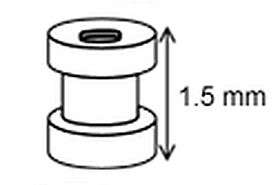Tympanostomy tube
| Tympanostomy tube | |
|---|---|
 The grommet is less than 2 mm tall, smaller than a match head. | |
| Synonyms | Grommet, T-tube, ear tube, pressure equalization tube, vent, PE tube, myringotomy tube |
Tympanostomy tube, also known as a grommet or myringotomy tube, is a small tube inserted into the eardrum in order to keep the middle ear aerated for a prolonged period of time, and to prevent the accumulation of fluid in the middle ear. The operation to insert the tube involves a myringotomy and is performed under local or general anesthesia. The tube itself is made in a variety of designs. The most commonly used type is shaped like a grommet. When it is necessary to keep the middle ear ventilated for a very long period, a "T"-shaped tube may be used, as these "T-tubes" can stay in place for 2-4 years. Materials used to construct the tube are most often plastics such as silicone or Teflon. Stainless steel tubes exist, but are no longer in frequent use.
Medical uses
.jpg)
Guidelines state that tubes are an option in:
- Recurrent acute otitis media: three ear infections in six months or four infections in a year.[1] The evidence for this recommendation; however, is weak.[1]
- Chronic otitis media with persistent effusion for six months (one ear) or three months (both ears).
- Persistent eustachian tube dysfunction
- Barotrauma: Especially for prevention of recurrent episodes (e.g., after air travel, hyperbaric chamber treatment).
Procedure

Although myringotomy with tube insertion can be performed under local anesthesia during a regular doctor's appointment in co-operative adults, patients requiring tube insertion are very often young children. Since damage to the ear is possible unless the patient stays quite still while being manipulated, any patient who may have difficulty lying still during the procedure typically undergoes myringotomy and tube insertion under general anesthesia.
The insertion of tympanostomy tubes is one of the most common surgical procedures performed on children. In the United States, it is the most common reason for a child to undergo a general anaesthetic.[2]
Outcome
Tympanostomy tubes generally remain in the eardrum for six months to two years, with T-tubes lasting up to four years. They generally spontaneously fall out of the eardrum as the skin of the eardrum slowly migrates out towards the ear canal wall over time. The eardrum usually closes without a residual hole at the tube site but in a small number of cases a perforation can persist. There is debate among clinicians as to whether long-lasting tubes are associated with a higher incidence of adverse outcomes, such as persistent perforation, cholesteatoma, tympanosclerosis and others, as opposed to tubes designed to last for shorter durations.
A common complication of getting a tympanostomy tube is experiencing otorrhea, which is a discharge from the ear.[3] Oral antibiotics should not be used to treat uncomplicated acute tympanostomy tube otorrhea.[3] Oral antibiotics are not a sufficient response to bacteria which cause this condition and have significant side effects including increased risk of opportunistic infection.[3] In contrast, topical antibiotic eardrops can treat this condition.[3]
References
- 1 2 Lieberthal, AS; Carroll, AE; Chonmaitree, T; Ganiats, TG; Hoberman, A; Jackson, MA; Joffe, MD; Miller, DT; Rosenfeld, RM; Sevilla, XD; Schwartz, RH; Thomas, PA; Tunkel, DE (March 2013). "The diagnosis and management of acute otitis media.". Pediatrics. 131 (3): e964–99. PMID 23439909. doi:10.1542/peds.2012-3488.
- ↑ Vaile L. Williamson T. Waddell A. Taylor G. Interventions for ear discharge associated with grommets (ventilation tubes)
- 1 2 3 4 American Academy of Otolaryngology – Head and Neck Surgery, "Five Things Physicians and Patients Should Question", Choosing Wisely: an initiative of the ABIM Foundation, American Academy of Otolaryngology – Head and Neck Surgery, retrieved August 1, 2013, which cites
- Rosenfeld, R. M.; Schwartz, S. R.; Pynnonen, M. A.; Tunkel, D. E.; Hussey, H. M.; Fichera, J. S.; Grimes, A. M.; Hackell, J. M.; Harrison, M. F.; Haskell, H.; Haynes, D. S.; Kim, T. W.; Lafreniere, D. C.; LeBlanc, K.; Mackey, W. L.; Netterville, J. L.; Pipan, M. E.; Raol, N. P.; Schellhase, K. G. (2013). "Clinical Practice Guideline: Tympanostomy Tubes in Children". Otolaryngology -- Head and Neck Surgery. 149 (1 Suppl): S1–S35. ISSN 0194-5998. PMID 23818543. doi:10.1177/0194599813487302.